Aladdin Sane by David Bowie
Buy Aladdin Sane The sixth studio album by David Bowie, 1973’s Aladdin Sane furthers the narrative, begun on the previous year’s hit album The Rise and Fall of Ziggy Stardust and the Spiders […]

Buy Aladdin Sane The sixth studio album by David Bowie, 1973’s Aladdin Sane furthers the narrative, begun on the previous year’s hit album The Rise and Fall of Ziggy Stardust and the Spiders […]

Buy Aerosmith Aerosmith emerged as a blues rock alternative in a music sea of glam rock and prog rock of the early 1970s. Their impressive 1973 debut album doesn’t contain anything particularly innovative […]

Buy Abandoned Luncheonette For all the success that this Philadelphia-based duo would experience later on in their career, Daryl Hall and John Oates struggled to find a commercial footing early on. That’s not […]